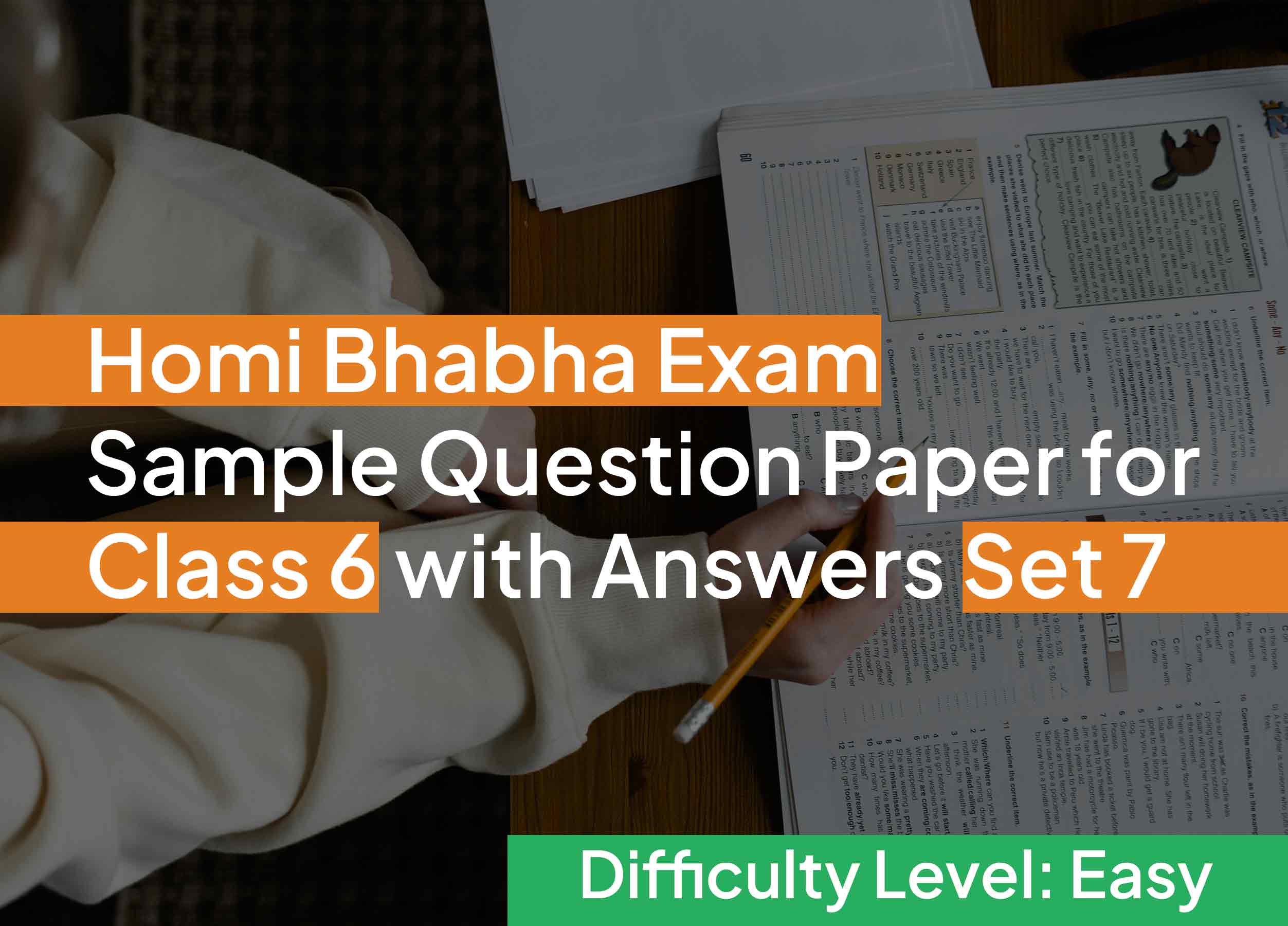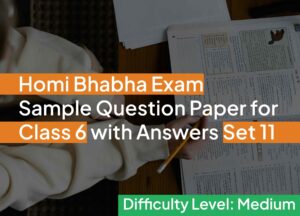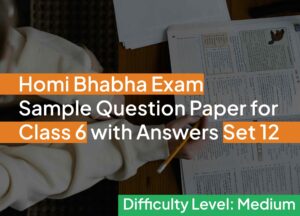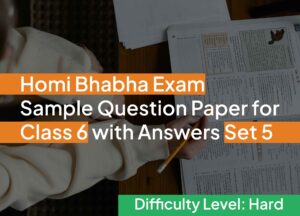Dr. Homi Bhabha Exam sample question paper for Class 6 with our comprehensive set 7 is designed specifically for students following the Maharashtra State Board curriculum, aligning perfectly with the textbooks for 4th, 5th, and 6th standards. This sample question paper is designed to challenge students with in-depth, analytical questions from Maharashtra State Board, CBSE, ICSE, and IB textbooks, covering fundamental science concepts at a high difficulty level.
With questions set at a easy difficulty level, students can effectively enhance their understanding and confidence. Each question aims to challenge students while reinforcing their knowledge, making this resource invaluable preparing for DHBBVS.
1. What is the main function of roots in plants?
a) Photosynthesis
b) Absorb water and nutrients
c) Produce seeds
d) Release oxygen
Answer: b) Absorb water and nutrients
Explanation: Roots help anchor the plant and absorb water and nutrients from the soil.
2. Which of the following is an example of a living thing?
a) Stone
b) Tree
c) River
d) Air
Answer: b) Tree
Explanation: Living things like trees grow, breathe, and reproduce, while non-living things do not.
3. Animals that feed on plants are called:
a) Carnivores
b) Herbivores
c) Omnivores
d) Scavengers
Answer: b) Herbivores
Explanation: Herbivores are animals that eat plants, like cows, deer, and rabbits.
4. Which organ is responsible for pumping blood throughout the human body?
a) Brain
b) Stomach
c) Lungs
d) Heart
Answer: d) Heart
Explanation: The heart pumps blood to circulate oxygen and nutrients throughout the body.
5. What process do plants use to make their food?
a) Digestion
b) Respiration
c) Photosynthesis
d) Transpiration
Answer: c) Photosynthesis
Explanation: Plants use sunlight, carbon dioxide, and water to produce their food through photosynthesis.
6. What is the boiling point of water?
a) 90°C
b) 100°C
c) 120°C
d) 150°C
Answer: b) 100°C
Explanation: Water boils at 100°C at sea level, which is a key physical property of water.
7. Which organ in the human body helps in breathing?
a) Heart
b) Kidneys
c) Lungs
d) Liver
Answer: c) Lungs
Explanation: The lungs allow us to inhale oxygen and exhale carbon dioxide.
8. What kind of energy does the Sun provide?
a) Electrical
b) Kinetic
c) Solar
d) Mechanical
Answer: c) Solar
Explanation: The Sun provides solar energy, which is harnessed by plants for photosynthesis and by humans for various uses.
9. What is the main component of air?
a) Carbon dioxide
b) Oxygen
c) Nitrogen
d) Hydrogen
Answer: c) Nitrogen
Explanation: Nitrogen makes up about 78% of the Earth’s atmosphere.
10. The smallest unit of matter is:
a) Atom
b) Molecule
c) Cell
d) Compound
Answer: a) Atom
Explanation: Atoms are the basic building blocks of all matter.
11. Which vitamin is commonly known as the “sunshine vitamin”?
a) Vitamin A
b) Vitamin B
c) Vitamin C
d) Vitamin D
Answer: d) Vitamin D
Explanation: The body synthesizes Vitamin D when the skin is exposed to sunlight.
12. Which type of soil is best for growing crops?
a) Sandy
b) Clay
c) Loamy
d) Rocky
Answer: c) Loamy
Explanation: Loamy soil contains a balanced mixture of sand, silt, and clay, which is ideal for plant growth.
13. Which gas do plants release during photosynthesis?
a) Nitrogen
b) Carbon Dioxide
c) Oxygen
d) Methane
Answer: c) Oxygen
Explanation: During photosynthesis, plants release oxygen as a byproduct.
14. What is the largest organ in the human body?
a) Heart
b) Brain
c) Liver
d) Skin
Answer: d) Skin
Explanation: Skin is the body’s largest organ, serving as a protective barrier.
15. Which planet is known as the “Red Planet”?
a) Earth
b) Venus
c) Mars
d) Jupiter
Answer: c) Mars
Explanation: Mars is known as the “Red Planet” due to its reddish appearance from iron oxide on its surface.
16. Which type of energy is stored in food?
a) Kinetic
b) Thermal
c) Chemical
d) Electrical
Answer: c) Chemical
Explanation: Food contains chemical energy, which is released during digestion.
17. How many bones are there in an adult human body?
a) 100
b) 206
c) 150
d) 250
Answer: b) 206
Explanation: An adult human has 206 bones, providing structure and protection.
18. Which part of the cell contains genetic material?
a) Cytoplasm
b) Cell wall
c) Nucleus
d) Mitochondria
Answer: c) Nucleus
Explanation: The nucleus houses DNA, which carries genetic information.
19. What is the source of energy for the water cycle?
a) Wind
b) Sun
c) Moon
d) Earth’s core
Answer: b) Sun
Explanation: The Sun’s heat causes water to evaporate, starting the water cycle.
20. What is the main purpose of the digestive system in the human body?
a) To pump blood
b) To control movement
c) To break down food
d) To filter waste
Answer: c) To break down food
Explanation: The digestive system breaks down food into nutrients the body can absorb.
21. What is the freezing point of water?
a) 50°C
b) 100°C
c) 0°C
d) -20°C
Answer: c) 0°C
Explanation: Water freezes at 0°C at standard atmospheric pressure.
22. Which part of a plant absorbs sunlight for photosynthesis?
a) Roots
b) Stem
c) Leaves
d) Flower
Answer: c) Leaves
Explanation: Leaves contain chlorophyll, which absorbs sunlight for photosynthesis.
23. Which organ in humans is responsible for filtering blood?
a) Heart
b) Liver
c) Kidneys
d) Lungs
Answer: c) Kidneys
Explanation: Kidneys filter waste from the blood and produce urine.
24. What is the main gas in the Earth’s atmosphere?
a) Oxygen
b) Carbon Dioxide
c) Nitrogen
d) Hydrogen
Answer: c) Nitrogen
Explanation: Nitrogen makes up about 78% of the atmosphere.
25. Which simple machine is used to lift objects easily?
a) Screw
b) Lever
c) Wedge
d) Pulley
Answer: b) Lever
Explanation: A lever helps lift heavy objects with less effort.
26. Which organ in plants takes in carbon dioxide from the air?
a) Roots
b) Stem
c) Flowers
d) Leaves
Answer: d) Leaves
Explanation: Leaves absorb carbon dioxide through tiny openings called stomata.
27. The process of turning a liquid into gas is called:
a) Condensation
b) Evaporation
c) Sublimation
d) Precipitation
Answer: b) Evaporation
Explanation: Evaporation occurs when a liquid turns into vapor, like water evaporating from a surface.
28. The closest planet to the Sun is:
a) Earth
b) Venus
c) Mercury
d) Mars
Answer: c) Mercury
Explanation: Mercury is the closest planet to the Sun, orbiting it faster than any other planet.
29. Which part of a plant is mainly responsible for reproduction?
a) Leaf
b) Root
c) Stem
d) Flower
Answer: d) Flower
Explanation: Flowers contain reproductive organs that produce seeds for new plants.
30. What type of energy is stored in a battery?
a) Light
b) Heat
c) Chemical
d) Sound
Answer: c) Chemical
Explanation: Batteries store chemical energy, which can be converted to electrical energy when needed.
31. What type of root system is found in most flowering plants?
a) Fibrous roots
b) Taproots
c) Aerial roots
d) Prop roots
Answer: b) Taproots
Explanation: Most flowering plants have a taproot system, where a main root grows vertically with smaller lateral roots branching off.
32. Which process in plants uses sunlight to create food?
a) Respiration
b) Photosynthesis
c) Germination
d) Pollination
Answer: b) Photosynthesis
Explanation: Photosynthesis is the process by which plants use sunlight, water, and carbon dioxide to produce food in the form of glucose.
33. In which part of the plant does photosynthesis primarily occur?
a) Roots
b) Stem
c) Leaves
d) Flowers
Answer: c) Leaves
Explanation: Photosynthesis mainly occurs in the leaves, which contain chlorophyll, allowing them to capture sunlight and convert it into food.
34. What causes day and night on Earth?
a) Earth’s revolution around the Sun
b) Earth’s tilt
c) Earth’s rotation on its axis
d) Movement of the Moon
Answer: c) Earth’s rotation on its axis
Explanation: Day and night occur due to Earth’s rotation on its axis, causing different parts of Earth to face or turn away from the Sun.
35. Which of the following gases is produced by plants during photosynthesis?
a) Nitrogen
b) Oxygen
c) Carbon dioxide
d) Hydrogen
Answer: b) Oxygen
Explanation: During photosynthesis, plants absorb carbon dioxide and release oxygen as a byproduct, which is essential for the respiration of most living organisms.
36. The process of separating solid particles from a liquid by pouring it into another container is called:
a) Filtration
b) Decantation
c) Evaporation
d) Distillation
Answer: b) Decantation
Explanation: Decantation involves carefully pouring a liquid away from settled solids.
37. What is the term for animals that eat both plants and animals?
a) Herbivores
b) Carnivores
c) Omnivores
d) Insectivores
Answer: c) Omnivores
Explanation: Omnivores consume both plant and animal matter.
38. Which vitamin is essential for blood clotting?
a) Vitamin A
b) Vitamin B
c) Vitamin K
d) Vitamin D
Answer: c) Vitamin K
Explanation: Vitamin K plays a crucial role in blood clotting.
39. What is the main component of the Sun?
a) Helium
b) Oxygen
c) Hydrogen
d) Nitrogen
Answer: c) Hydrogen
Explanation: The Sun is composed primarily of hydrogen, undergoing nuclear fusion to produce energy.
40. Which part of the brain controls balance and coordination?
a) Cerebrum
b) Cerebellum
c) Brainstem
d) Spinal cord
Answer: b) Cerebellum
Explanation: The cerebellum is responsible for balance, posture, and coordination.
If you find this useful, share it with your friends… so they can join you in preparing for Dr. Homi Bhabha Balvaidnyanik Competition or DHBBVS. Together, you can tackle these questions, discuss the answers, and strengthen your knowledge base.
Start reading, keep preparing and stay focused! Let’s achieve greatness together!




